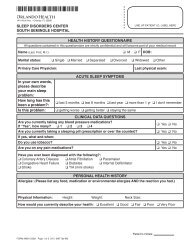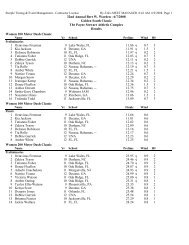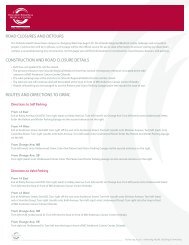Advanced Hemodynamics - Orlando Health
Advanced Hemodynamics - Orlando Health
Advanced Hemodynamics - Orlando Health
Create successful ePaper yourself
Turn your PDF publications into a flip-book with our unique Google optimized e-Paper software.
Line Setup & Zeroing of a Transduced System<br />
<strong>Advanced</strong> Hemodynamic Monitoring<br />
The majority of hemodynamic monitoring systems are set up in a similar manner. The exact type of<br />
transducer system used varies among institutions. Review the policies and guidelines where you<br />
work for more specific information.<br />
Equipment<br />
Assemble all components of the system prior to set up (this may be performed by a nurse, a<br />
respiratory therapist or a technician). The components include:<br />
Pressure cuff (pressure pack) for IV bag<br />
One liter bag of normal saline<br />
Pre-assembled, disposable pressure tubing with flush device and disposable transducer and<br />
stopcocks<br />
I.V. pole with transducer mount (called a manifold)<br />
Carpenter’s level or other leveling device<br />
Patient monitor, pressure module and monitor cable<br />
Equipment Set-up<br />
1. Obtain a 1000 ml bag of 0.9% saline; invert the bag and spike it with IV tubing, then turn it<br />
upright and fill the drip chamber until it is completely full.<br />
2. The tubing comes with stopcock caps with holes in them so one does not have to remove<br />
the caps prior to priming the tubing. Position all stopcocks so the flush solution will flow<br />
through the entire system. Be sure to flush all the stopcock ports. Roll the tubing’s flow<br />
regulator to the OFF position.<br />
3. Activate the fast flush device and flush the saline through the entire setup one more time.<br />
Check to be sure that all air has been purged from the system. Examine the transducer and<br />
each stopcock carefully, as small bubbles tend to cling to these components. Air left in the<br />
tubing can cause inaccurate transmission of pressure to the transducer.<br />
4. Replace all vented (the ones with holes) port caps with closed (dead-end) caps, making<br />
sure to maintain the sterility of each cap’s insertion end.<br />
5. Place the bag of saline into the pressure bag, and adjust the pressure to at least 300 mm Hg.<br />
This is the pressure that is required to maintain a continuous flow of 3-5 ml/minute through<br />
the intraflow valve. This helps prevent clotting of the catheter and backflow of blood into<br />
the tubing.<br />
6. Before the monitor can measure pressures, the transducer must be zeroed to atmospheric<br />
pressure. The purpose of this procedure is to make sure the transducer reads zero when no<br />
pressure is against it. This procedure is like zeroing a scale before weighing something to<br />
assure accuracy. To zero the transducer, place the stopcock so it is open between the<br />
transducer and air, and press the zero button on the monitor. Zeroing can be performed<br />
whether or not the patient is attached to the system, so no particular patient position is<br />
required to complete this step. The transducer should be re-zeroed whenever the reading is<br />
in doubt, or anytime the monitor has been disconnected from the transducer setup.<br />
Copyright 2010 <strong>Orlando</strong> <strong>Health</strong>, Education & Development 12

















